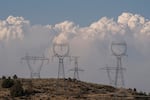Data centers being rapidly built in the West are becoming an “emerging risk” to electrical grid reliability in the region, according to regional transmission experts.
New data centers, which can be built in as little as 18 months, are far outpacing the growth in new electrical energy supply and transmission, according to members of the Western Electricity Coordinating Council, a nonprofit organization based in Salt Lake City that ensures grid connection and reliability between utilities in 14 western states and parts of Canada and Mexico. Members of the council discussed challenges to grid reliability at a recent webinar first reported by the trade publication RTO Insider.

Data centers like this Google data center, pictured in The Dalles, Ore., in this Oct. 5, 2021 file photo, are far outpacing the growth in new electrical energy supply and transmission, according to a recent study by a nonprofit organization based in Salt Lake City, Utah.
Andrew Selsky / AP
In it, council members said new energy demand from data centers has emerged as a more prescient challenge than meeting energy demand for transportation, also becoming rapidly electrified. The energy and transmission buildout needed to meet these demands is lagging, they said. By the end of 2023, just about half of the new energy buildout anticipated for the West had been completed. This is due in large part to supply chain issues, prices and skilled labor shortages, according to Branden Sudduth, the commission’s vice president of reliability planning.
There are more than 700 data centers within those 14 states, including 109 in Oregon, according to the company Data Center Map, and there are more than 5,000 data centers throughout the U.S. according to Statista – the most for any single country in the world.
Oregon’s data center market is the fifth largest in the nation, according to Chicago-based commercial real estate group Cushman & Wakefield. Amazon, Apple, Facebook, Google and X, formerly named Twitter, have massive data centers in eastern Oregon as well as in The Dalles, Hillsboro and Prineville that require enormous amounts of energy to operate. Amazon is planning to build at least 10 more data centers in eastern Oregon, according to reporting by The Oregonian/OregonLive.
“We’re going to see an industry that wants to come online quickly with very large loads, and how are we going to address that?” Sudduth said.
The council in 2023 projected that demand for electricity in the West would increase about 17% by 2033 – that’s about twice what it had predicted just the year before. That leap in projected energy use is due largely to the number of large data centers being built, they said. Data centers run on large amounts of energy needed for processing and for cooling servers.

The power grid in the West faces another big challenge besides data centers: Extreme weather, which can down power lines like those shown in this July 12, 2021 file photo taken near Klamath Falls, Ore.
Nathan Howard / AP
The Portland-based industry trade group Pacific Northwest Utilities Conference Committee has projected electricity demand to grow 30% in the region in the next decade, also due in large part to data centers.
Another major challenge to grid reliability discussed was extreme weather. Sudduth said more energy sources and transmission would need to be developed both at the local level and across the region to ensure a reliable electricity supply.
“Pretty much since the August 2020 heat wave event, the weather patterns that we’re experiencing are different from what we’ve typically planned for in the past. A lot of the weather events are more widespread and they last a lot longer than they have in the past,” Sudduth said.
A growing number of utilities in Oregon and Washington are joining a new western regional market for buying and selling energy from one another at set prices for the day ahead, so that they can better handle demand spikes during extreme weather events, such as heat waves or ice storms. The Bonneville Power Administration – responsible for about 28% of all power consumed in the Northwest – is expected to announce soon whether it will join most other Western utilities in this Western day ahead market, or go to a competing day ahead market run by the Southwest Power Pool, based in Arkansas.
Oregon Capital Chronicle is part of States Newsroom, a network of news bureaus supported by grants and a coalition of donors as a 501(c)(3) public charity. Oregon Capital Chronicle maintains editorial independence. Contact Editor Lynne Terry for questions: info@oregoncapitalchronicle.com. Follow Oregon Capital Chronicle on Facebook and X.